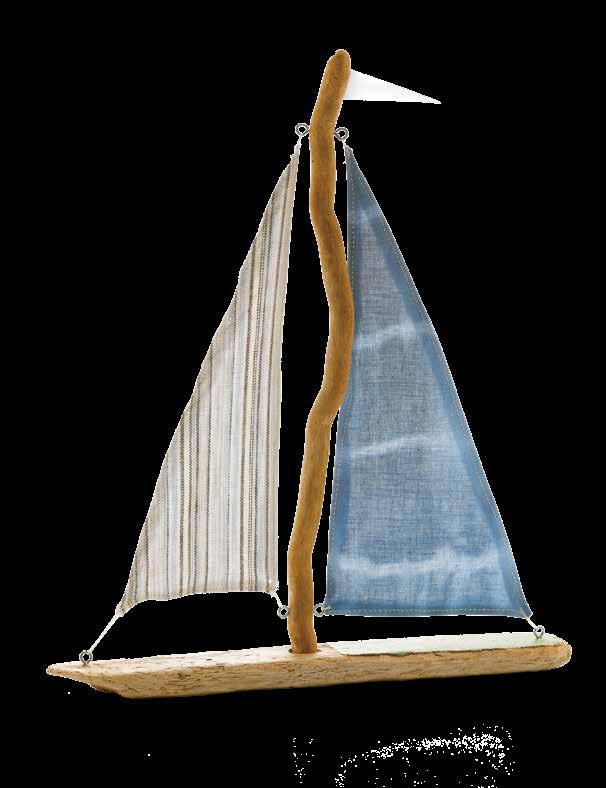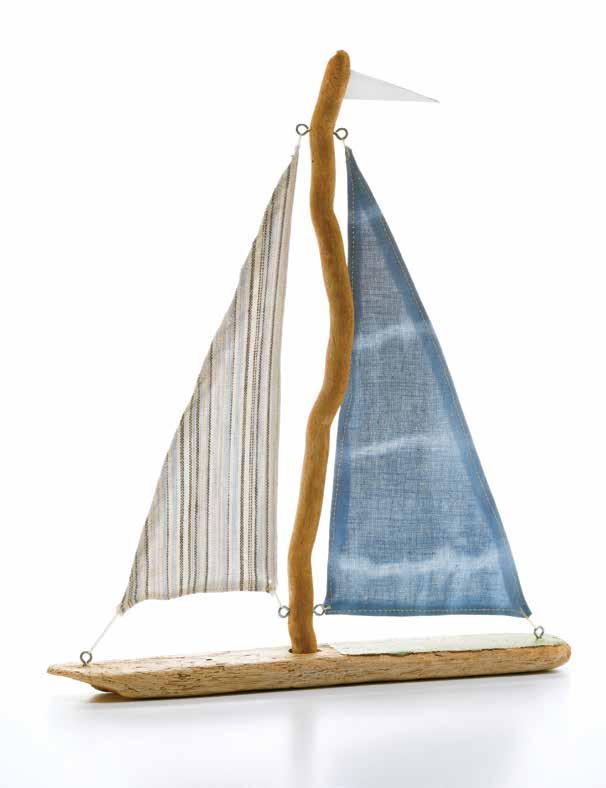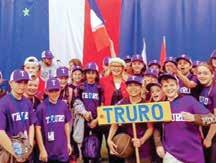
12 minute read
DIY
MEDITERRANEAN appeal
BY TRACY STUART
MEDALLING WITH MY FOOD
Tracy is an Olympic medallist and has a Chef’s Diploma from the Natural Gourmet Institute for Health and Culinary Arts.
Can you think back to a time in your life when you experienced a food that was different than the traditional food you grew up with? It happened to me during my second summer of university at Acadia. I applied for a summer job at The Kitchen Door, which was a small, mainly takeaway bistro, that served Italian and Mediterraneanstyle food. I had no experience whatsoever with this type of cuisine aside from basics like spaghetti (which they didn’t serve).
That summer I experienced a whole new world of food and flavour that I immediately fell in love with. Pesto, sundried tomatoes, olives, certain pastas like orzo and tortellini, along with different grains like couscous and farro became a staple in my diet.
My love affair with Mediterranean food deepened as I spent multiple summers in Italy during my time on the international rowing circuit. No matter where I was or how many years had passed there was one recipe that I kept coming back to time and time again. Carol DeMatteis, the head chef, and owner of The Kitchen Door, had no idea how much of a gift that summer was to me. I have literally made her Greek Salad recipe hundreds of times over the years and it is one that I will hand down to my children, for sure. When made with the freshest ingredients, this salad is not only appealing to the eye but also to the tastebuds of all ages. It is a perfect side to serve with just about any clean protein that you cook up on the BBQ, or it can stand alone as a quick lunch on the go.
One of the big principles of health-supportive meal preparation is that we eat from the rainbow. Dr. Mark Hyman in his cookbook, FOOD What the Heck Should We Eat, advises us to eat an assortment of colourful plants on a daily basis and you’ll reap the benefits of numerous phytonutrients, vitamins, and minerals that support optimal health. Our food contains information that our bodies use to heal; my rule of thumb is to always have at least two different colours of vegetables on the plate at every meal. There is no question that this recipe has got you covered. Delicious and nutritious, you can’t beat it.
The original recipe that I’d written down is long gone, so this is mostly a free-wheeling meal, but I have done my best to put numbers to it. However, feel free to change any of the quantities to suit your taste. From The Kitchen Door to my kitchen, and now to yours, enjoy!
1 English Cucumber, quartered and deseeded, cut into 1-inch chunks 2 Tomatoes, quartered and deseeded, cut into 1-inch chunks ½ Sweet Pepper of any colour, deseeded, cut into 1-inch chunks ¼ Red Onion (or red cabbage for non-onion lovers), thinly sliced ½ cup Kalamata Olives, pitted ¼ cup Feta Cheese, diced 1 Tbsp Extra-virgin Olive Oil Juice of ½ lemon freshly squeezed 1 Tbsp Dried Oregano 1 tsp Salt (or to taste) ½ tsp Pepper
Greek Salad
Serves 4 | Preparation time: 10 minutes
Preparation 1. Cut all vegetables in like-sized, bite-sized chunks. 2. Add the olives and feta cheese 3. Drizzle with olive oil and lemon juice 4. Season with oregano, salt, and pepper to taste
Boost your body’s natural UV defence
BY DR. AMY PUNKÉ
support your skin from within
the sun has finally arrived in Nova Scotia and it’s just what the doctor ordered! I have noticed an increase in energy in a lot of my patients, moods are starting to improve, and skin complaints (such as eczema, acne, and psoriasis) are reduced. There are many wonderful things about the sun, but of course, we still must be careful.
As I sit down to write this, I am reminded that May is Skin Cancer Awareness Month. According to Health Canada, skin cancer is one of the most common types of cancer in this country. With one in six Canadians diagnosed with skin cancer every year, and more than 85,000 cases seen annually by healthcare providers, I thought it was worth talking about.
I remember when I was a kid growing up in Australia in the 80s, sun protection was always part of our day: we weren’t allowed to play outside at lunchtime unless we were wearing a hat that had a flap on the back that covered our necks, and we would all run around with brightly coloured strips of zinc oxide painted on our noses so we wouldn’t get a sunburn.
We thought we were being proactive and protecting ourselves from the sun by buying a bottle of sunscreen. However, a lot of research is coming out warning us that, with certain products, we may be doing more harm than good.
Fortunately, the EWG (Environmental Working Group) has launched a “Sun Safety” campaign in partnership with dermatologists and sunscreen companies. The campaign aims “to make sun safety as essential as seat belts.” The EWG states, “Much blame falls on poor-quality sunscreens and misleading sunscreen advertising that leads people to believe, wrongly, that their products protect their skin from too much sun.”
It may seem counterintuitive, but we should avoid sunscreens with a high SPF.
SPF, short for “sun protection factor,” only offers protection against UVB radiation which burns the skin. The EWG reports that SPF does not protect your skin from the sun’s UVA rays. UVA rays penetrate deep into the skin, suppress the immune system, accelerate skin aging, and may increase your risk of developing skin cancer. Products with extremely high SPFs may protect against sunburn but can leave skin exposed to damaging UVA rays. The EWG recommends that consumers avoid products labelled with anything higher than SPF 50 and reapply sunscreen often, regardless of SPF. When buying a sunscreen, avoid the ingredients, oxybenzone, octinoxate, octisalate, octocrylene, and homosalate. These are
chemicals that help absorb UV rays and are contained in more than half of sunscreens on the market. These chemicals have been shown to be toxic when absorbed through the skin and enter the bloodstream. They have also been linked to hormone disruption in women. While we are all familiar with the importance of sunscreen, wearing hats, and avoiding the sun during the hottest time of the day, here are few other tips I recommend to not only protect your skin in the summer but to support your health all year round. Support your skin’s natural barrier, AKA the epidermal barrier. The outermost layer of our skin, the epidermis, is our first line of defence to the external environment and, therefore, is crucial for skin health. Our bodies in their innate wisdom, are constantly maturing and shedding this outer layer of skin cells. Once, this outer layer was just thought to be dead skin cells serving no biological function. We now know that these cells are, in fact, live tissue that performs protective and adaptive physiological functions. These cells are critical in preventing aging, infection, acne, protecting our skin from the sun, and dehydration. Unfortunately, this outer layer of skin cells has been blamed for wrinkles, uneven skin tone, acne, and dull, lifeless skin. This is the reason exfoliating with scrubs and acids/chemical peels and dermabrasion are so popular. However, over-exfoliating can leave your skin more vulnerable to UV damage from the sun. To support your skin’s natural cycle of shedding, exfoliating should occur no more than once every three to four weeks. Rather than frequent exfoliating, it would be a wiser plan to support skin health from within. A diet rich in omega essential fatty acids (found in fish, raw nuts, and seeds) and antioxidants (dark leafy greens and other brightly coloured fruits and veggies) have been shown to increase the body’s “natural UV protection.” A study published last year in the Journal of Natural Health Product Research showed that ingesting photoprotective natural compounds through diet or supplementation (i.e., fish oil and other potent antioxidants) showed a reduction in UV-induced cell death by increasing cellular antioxidant capacity and reducing the inflammatory response (aka, an increase in the skin’s UV-resistance). We need to have fun in the sun. We also need to be informed about how to have that fun without causing ourselves harm. This summer, be mindful of the power of sunlight, be grateful for all the benefits the sun brings while remaining ever mindful of its effects on your skin.
Download your free sunscreen guide from EWG at: www.ewg.org/sunscreen/
THE NATURE OF Naturopathic Medicine
Dr. Amy Punké is a member in good standing with the Nova Scotia Association of Naturopathic Doctors (NSAND) and the Canadian Association of Naturopathic Doctors (CAND). Licensed with the College of Naturopathic Doctors of Alberta (CNDA).
BY LORI DALING PHOTO BY STEVE SMITH, VISIONFIRE STUDIOS



Dreaming of warm, sunny summer days on the water? Collecting driftwood is always a fun way to enjoy the beach weather. But what do you do with all the driftwood you collect? Why not make yourself a sailboat to help you remember these lazy hazy days long after summer has come and gone? If you happen to hoard fabric as well as driftwood, this is a great way to use some of those scraps up, too.

STEP 1. Drill a hole in the middle of the flat piece — the base of your boat. STEP 2. Dry fit the mast into the hole to be sure the hole is the right size. STEP 3. Add eyelets on the top and bottom of either side of the mast and one on each end of the boat. STEP 4. Glue the mast into the hole and let dry while you make your sails. STEP 5. Trace out two triangles on the interfacing that will fit the triangular spacing between the eyelets and cut out. STEP 6. Iron interfacing onto your fabrics and trim leaving enough of an edge to fold over. STEP 7. Iron over edges and sew into place. STEP 8. Hand stitch corners of sails into the eyelets. STEP 9. Cut a triangle out of cardboard and glue to the top of the mast. STEP 10. Sail away on summer memories!

SUPPLIES
Long, flat piece of driftwood for the boat Tall, skinny, round piece of driftwood for the mast 2 different fabrics Iron-on interfacing 6 small eye hooks Thread and needle Sewing machine Scissors Iron and ironing board Drill and drill bit the size of your mast Glue Cardboard
SUPPORTING EACH OTHER IS AN IMPORTANT PART OF WHO WE ARE AS CANADIANS.
Lenore Zann, Member of Parliament
In the House of Commons, Ottawa
$2.84 million in Supports for Health, Long Term Care and Education!
Glad to secure funding for energy efficiency and safety for hospitals, long term care and schools through the Dept. of Infrastructure and Communities. $792,000 for Colchester East Hants Centre, $400,000 for Cumberland Regional Health Care Centre and $215,876 for the Willow Lodge long term care centre in Tatamagouche, $72,000 for Parrsboro Elementary, $264,000 for Amherst Regional High, $252,000 for E.B. Chandler Junior High, $68,000 for Cyrus Eaton Elementary, $520,000 For Valley Elementary and $252,000 for Hilden Elementary.
Lenore visits Truro senior Art Deveau. (Pre-Covid)
The spirit of the entrepreneur is alive and well in Ernest Korankye, founder, president and CEO of Asante Logistics Group in Truro. Asante Logistics Group benefited from our Canada Emergency Wage Subsidy Program, as well as accessing the $60,000 in interest-free loans provided to small businesses and non-profits to cover operating costs during the pandemic. Photo: Lenore outside with Ernest Korankye Kwe! Congratulations to Ulnooweg Development Group of Millbrook First Nations for being a vibrant force helping Atlantic Canadian Indigenous entrepreneurs and businesses attain their goals. They have received $857,000 in Federal funding to bring ocean based indigenous businesses together with the Centre for Ocean Ventures and Entrepreneurship (COVE) and Upswing Solutions, to build and grow viable industries while ensuring the sustainability of our ocean environments. Wela’lioq




Lenore is pictured with Chris Googoo, COO, Ulnooweg Development Group Lenore with Les Jeux Acadie at Truro Acadian School (Pre-Covid)
Covid 19 Vaccination!
Thank you Dr. Linda Ferguson at the Fundy Trail Mall Clinic. I am proud to bring supports for more accessibility through the
Enabling Accessibility Fund.
Congratulations to the Municipality of the County of Colchester for receiving $100,000, the Village of Bible Hill $75,927, the Rath Eastlink Community Centre $41,278 and Factory 58 Holding Inc. $100,000.




Safe driving on the roads this season, and motorists please watch for bikes! Photo: Blessing of the Bikes (Pre-Covid) Al Roland (with Lenore)
Hold the course Cumberland Colchester! Look after each other now by staying put and soon we will enjoy a warm summer – together! Bass River, Bay of Fundy
While Covid-19 is not over, the Government of Canada remains steadfast in our commitment to do whatever it takes, for as long as it takes, to protect you and your family.
This includes: • Getting a VACCINATION to every Canadian • Working with Nova Scotia to ensure a stronger
HEALTH CARE SYSTEM • Building a solid ECONOMY that is more fair and inclusive • Supporting women and families with accessible
CHILDCARE • Making SENIORS a priority • Protecting the environment and acting on
CLIMATE CHANGE

Strength that you can count on in extraordinary times
My team and I will help bring clarity to your financial situation by delivering personalized wealth management services and solutions. We work with high-net-worth clients across Northern Nova Scotia to build, protect, and transfer their wealth.
To learn more about our team, and how we can help you gain peace of mind during these uncertain times, contact us today.
Blair Carter, CFP Vice-President and Wealth Advisor blair.carter@rbc.com 902-893-2518
Jon David Fitzpatrick Administrative Assistant jondavid.fitzpatrick@rbc.com 902-832-5722
Michelle Mills-Wood Associate michelle.mills-wood@rbc.com 902-421-8335
105A Walker St. Truro, Nova Scotia, B2N 4B1
blaircarter.ca










